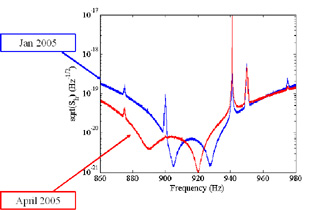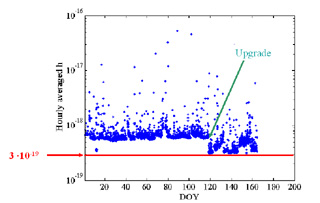 |
Present status
EXPLORER has been working in this configuration since 2000, after a
significant upgrade. At the beginning of 2004 minor changes were done in
the transducer and since then the antenna is in data taking. The present
is one of the longest continuous run of this antenna: in the past, runs
were interrupted by the the annual closure of CERN. This year an effort
was made to maintain the experiment in operations even during Christmas
time, extending the continuous data taking well beyond the usual 10
months. During the first part of the run EXPLORER was working with a
sensitivity h = 5 · 10−19 for short conventional bursts of GWs.
On March of 2005, increasing the electromechanical coupling of the readout
(i.e. increasing the electrical field inside the transducer) a significant
improvement of the performances was obtained, reaching a sensitivity for
short burst of h = 3·10−19. Presently the overall sensitivity
of the experiment (red curve in figure1) is limited by the electronic
noise.
The detector duty cycle is about 80% due to cryogenic operations and maintenance.
|
 Figure 1: Experimental strain sensitivity of
EXPLORER before (blue curve) and after the upgrade (red curve).
The peak sensitivity is about 1 10-21 Hz-1/2.
The spectral
amplitude is better than 1 10-20 Hz-1/2 over a band
of about 45 Hz. The peak at 940 Hz is a calibration reference signal
fed into the d.c. SQUID amplifier to monitor the gain of the electronics.

Figure 2: Detector
sensitivity to bursts versus time, averaged every
hour,
over 2005. The average
minimum detectable amplitude h of a GW burst of duration 1 ms is h
= 3 10-19, after the upgrade in april 2005. |
 |
